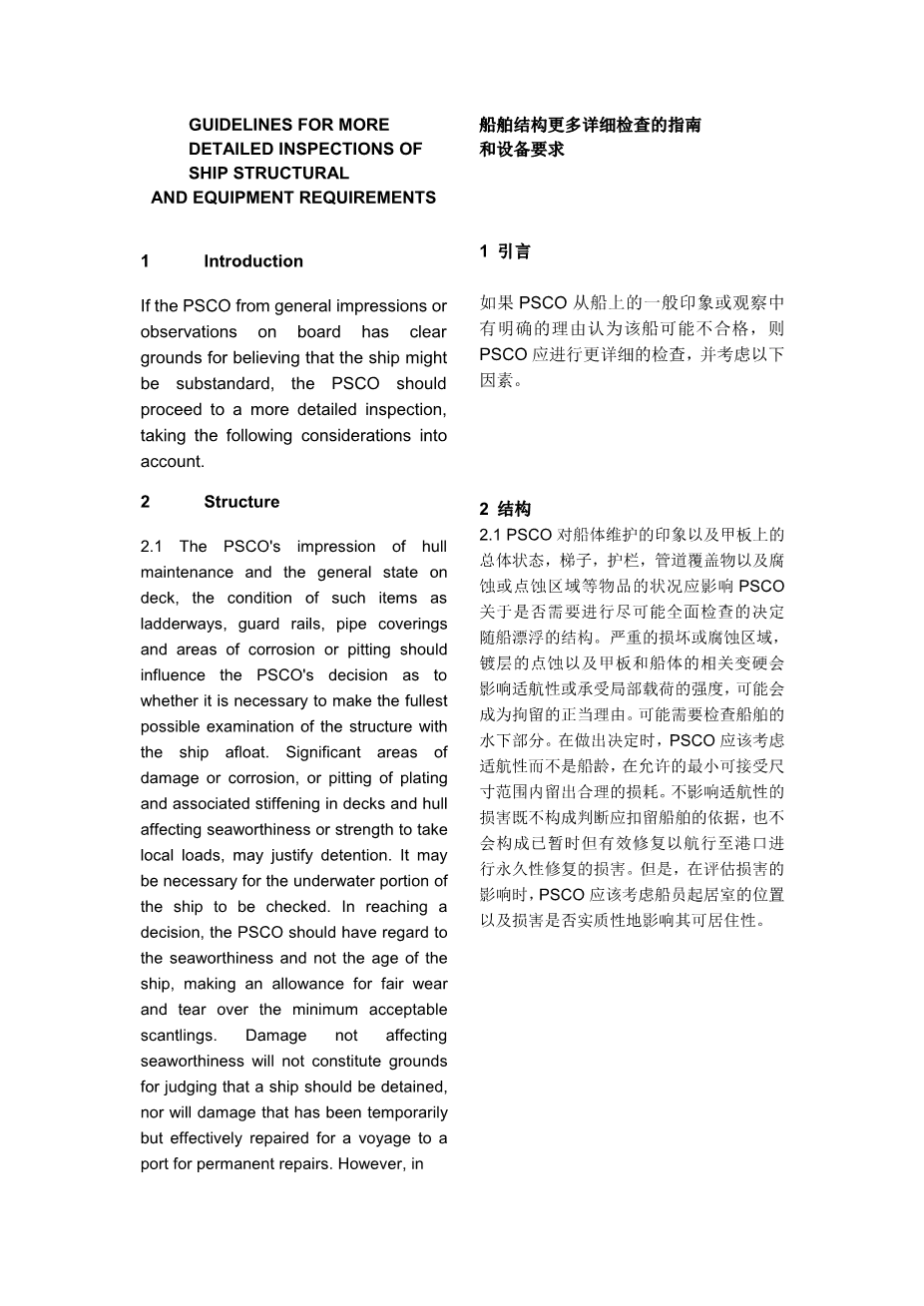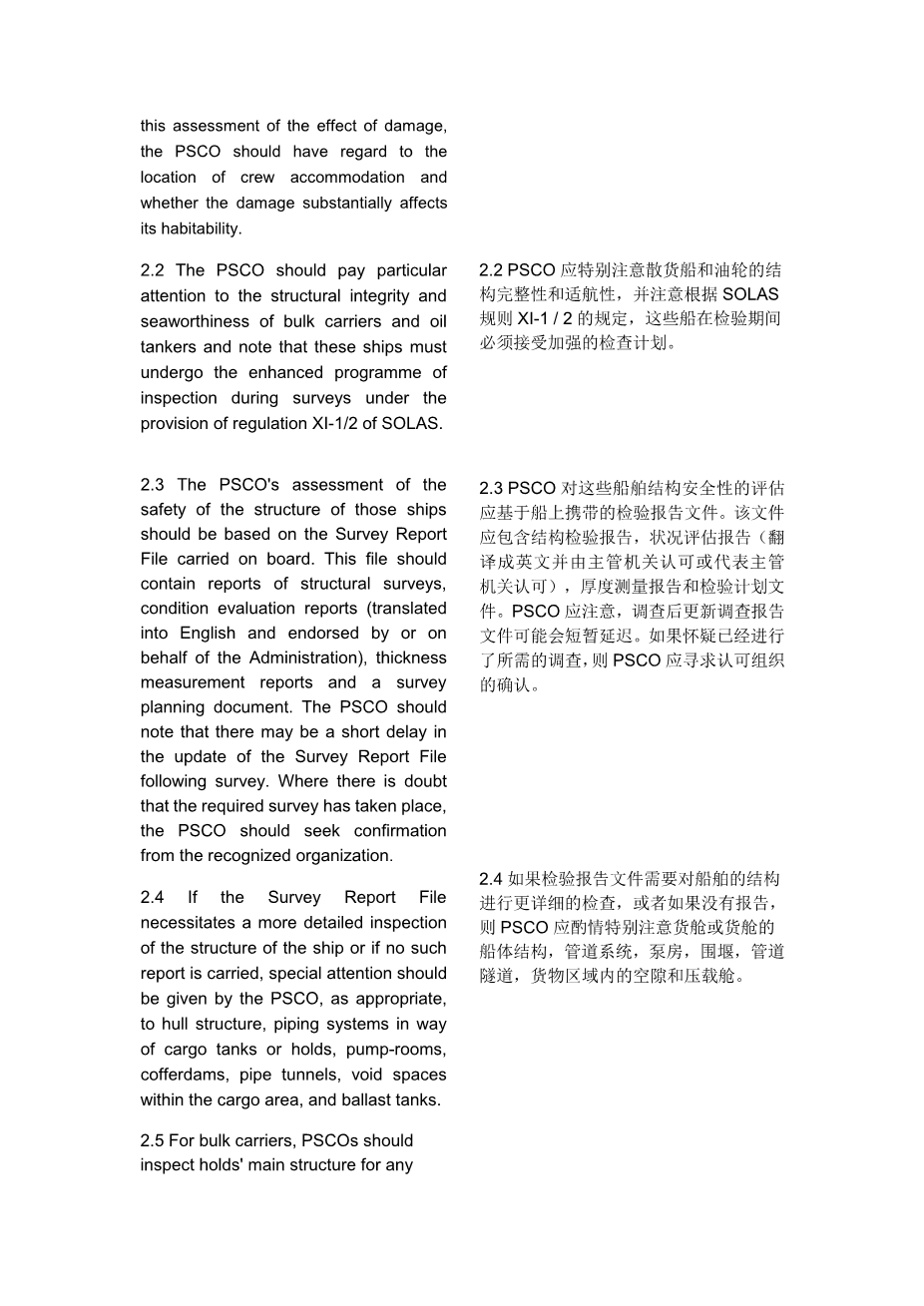Page 52
APPENDIX 6
GUIDELINES FOR MORE DETAILED INSPECTIONS OF SHIP STRUCTURAL
AND EQUIPMENT REQUIREMENTS
1 Introduction
If the PSCO from general impressions or observations on board has clear grounds for believing that the ship might be substandard, the PSCO should proceed to a more detailed inspection, taking the following considerations into account.
2 Structure
2.1 The PSCOs impression of hull maintenance and the general state on deck, the condition of such items as ladderways, guard rails, pipe coverings and areas of corrosion or pitting should influence the PSCOs decision as to whether it is necessary to make the fullest possible examination of the structure with the ship afloat. Significant areas of damage or corrosion, or pitting of plating and associated stiffening in decks and hull affecting seaworthiness or strength to take local loads, may justify detention. It may be necessary for the underwater portion of the ship to be checked. In reaching a decision, the PSCO should have regard to the seaworthiness and not the age of the ship, making an allowance for fair wear and tear over the minimum acceptable scantlings. Damage not affecting seaworthiness will not constitute grounds for judging that a ship should be detained, nor will damage that has been temporarily but effectively repaired for a voyage to a port for permanent repairs. However, in this assessment of the effect of damage, the PSCO should have regard to the location of crew accommodation and whether the damage substantially affects its habitability.
2.2 The PSCO should pay particular attention to the structural integrity and seaworthiness of bulk carriers and oil tankers and note that these ships must undergo the enhanced programme of inspection during surveys under the provision of regulation XI-1/2 of SOLAS.
2.3 The PSCOs assessment of the safety of the structure of those ships should be based on the Survey Report File carried on board. This file should contain reports of structural surveys, condition evaluation reports (translated into English and endorsed by or on behalf of the Administration), thickness measurement reports and a survey planning document. The PSCO should note that there may be a short delay in the update of the Survey Report File following survey. Where there is doubt that the required survey has taken place, the PSCO should seek confirmation from the recognized organization.
2.4 If the Survey Report File necessitates a more detailed inspection of the structure of the ship or if no such report is carried, special attention should be given by the PSCO, as appropriate, to hull structure, piping systems in way of cargo tanks or holds, pump-rooms, cofferdams, pipe tunnels, void spaces within the cargo area, and ballast tanks.
2.5 For bulk carriers, PSCOs should inspect holds main structure for any obviously unauthorized repairs. For bulk carriers the port State control officer should verify that the bulk carrier booklet has been endorsed, the water level alarms in cargo holds are fitted, and where applicable, that any restrictions imposed on the carriage of solid bulk cargoes have been recorded in the booklet and the bulk carrier loading triangle is permanently marked.
Page 53
3 Machinery spaces
3.1 The PSCO should assess the condition of the machinery and of the electrical installations such that they are capable of providing sufficient continuous power for propulsion and for auxiliary services.
3.2 During inspection of the machinery spaces, the PSCO should form an impression of the standard of maintenance. Frayed, disconnected or inoperative quick-closing valve wires, disconnected or inoperative extended control rods or machinery trip mechanisms, missing valve hand wheels, evidence of chronic steam, water and oil leaks, dirty tank tops and bilges or extensive corrosion of machinery foundations are pointers to an unsatisfactory organization of the systems maintenance. A large number of temporary repairs, including pipe clips or cement boxes, will indicate reluctance to make permanent repairs.
3.3 While it is not possible to determine the condition of the machinery without performance trials, general deficiencies, such as leaking pump glands, dirty water gauge glasses, inoperable pressure gauges, rusted relief valves, inoperative or disconnected safety or control devices, evidence of repeated operation of diesel engine scavenge belt or crankcase relief valves, malfunctioning or inoperative automatic equipment and alarm systems, and leaking boiler casings or uptakes, would warrant inspection of the engine-room logbook and investigation into the record of machinery failures and accidents and a request for running tests of machinery.
3.4 If one electrical generator is out of commission, the PSCO should investigate whether power is available to maintain essential and emergency services and should conduct tests.
3.5 If evidence of neglect becomes evident, the PSCO should extend the scope of an investigation to include, for example, tests on the main and auxiliary steering gear arrangements, overspeed trips, circuit breakers, etc.
3.6 It must be stressed that while detection of one or more of the above deficiencies would afford guidance to a substandard condition, the actual combination is a matter for professional judgement in each case.
4 Conditions of assignment of load lines
It may be that the PSCO has concluded that a hull inspection is unnecessary but, if dissatisfied on the basis of observations on deck, with items such as defective hatch closing arrangements, corroded air pipes and vent coamings, the PSCO should examine closely the conditions of assignment of load lines, payin
剩余内容已隐藏,支付完成后下载完整资料


英语译文共 26 页,剩余内容已隐藏,支付完成后下载完整资料
资料编号:[235801],资料为PDF文档或Word文档,PDF文档可免费转换为Word


